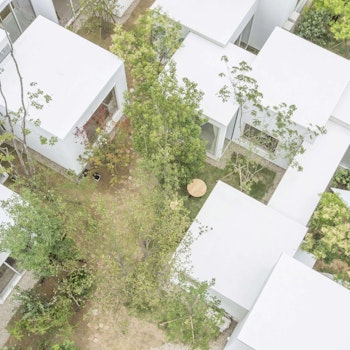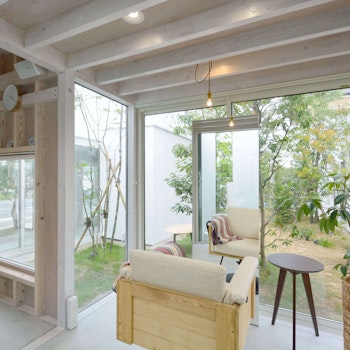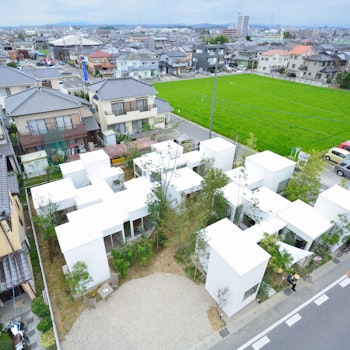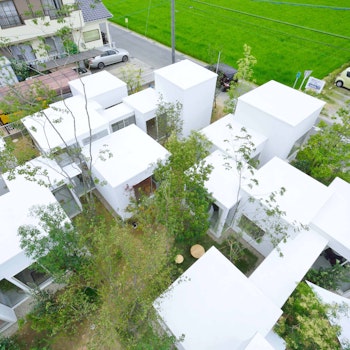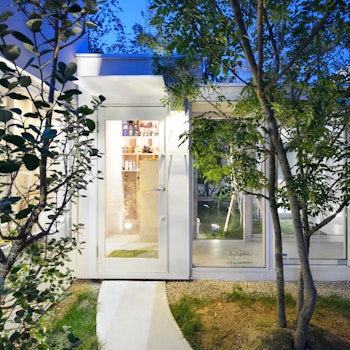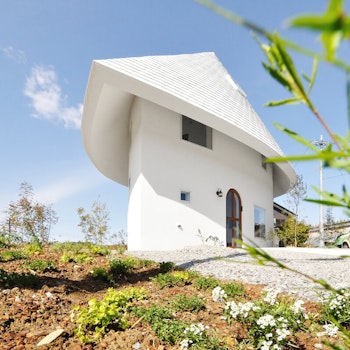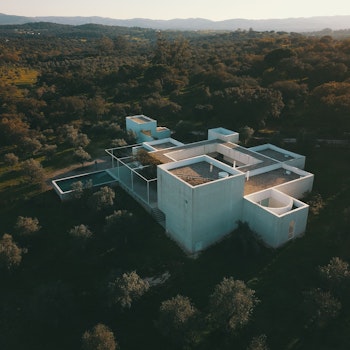ARCHITECT
STUDIO VELOCITY
House in Yanagibata is a private beauty salon and a family home. The site is located on the edge of an intersection and integrates a bus stop and walkway. Surrounding the site there is a crowded ‘flagpole’ development, a rice paddy field and other vast open spaces such as a parking lot. Nearby there are large non-residential buildings such as a hospital, a welfare facility and a nursery school. In other words, the size and density varies across the area. To the north, the street adjacent to the flagpole site has created a small community space. Along the southern road in front of the site, there is a bus stop where strangers gather together. This is much like a small public space in the city. The combination of large facilities/small residential, dense areas/vast open spaces, local communities/urban public spaces, has created a loosely connected and often contradictory environment. A range of 26 small connected buildings were created, with gathering and separating spaces and their uses as required. In turn, the external space was adjusted by repeating the scale and density of the interior space. The internal spaces flow and expand from one space to another, much like connecting rain drops. Several small buildings are tied together to make a single living space. The exterior gardens, trees, walkway, and bus stop are equivalent to the interior living room, study, storeroom, reception and hair salon. Thus, the environment created is free of hierarchies. The small 26 buildings provide an open space to relieve the sense of density from the surrounding flagpole site. The diagonal walkway creates a shortcut across the site. The big trees balance the scale of the surrounding buildings and the proportion of the paddy fields and car parking lot. Our approach considered how independent buildings are connected in section. At some sections, gardens and internal spaces repeat in a similar scale to create a separate building form; at other sections, it will be a single long room. The repetition of internal and external spaces gives a sense of a larger environment, purposefully mimicking the surrounding proportions of neighboring sites. Each structure is made of four 90mm corner pillars by a traditional axis paired method of construction. The reduced pillar size responds to the smaller proportions of each building. 26 buildings are gathered as 8 groups of complementary relationships. Between each group load bearing walls are arranged. For example, there is no load bearing walls in the dining room; structural loads are transferred to the next building which is the kitchen and children’s room. By gathering a strong building and a weak building, the structure is completed. Every day buses stop at the site to pick up waiting passengers. Every hour a different guest comes to the beauty salon. The grandfather of the client, who lives nearby, often comes to site to water the trees and plants. Children pass by the route next to the site and see the trees on their way to piano classes. The organization of small porous elements becomes part of the density of the city. Much like a sponge, it draws in the various environments of the surrounding area and mixes it with the small yet significant lives unfolding on site.
source: studio velocity
YOU MAY ALSO LIKE

